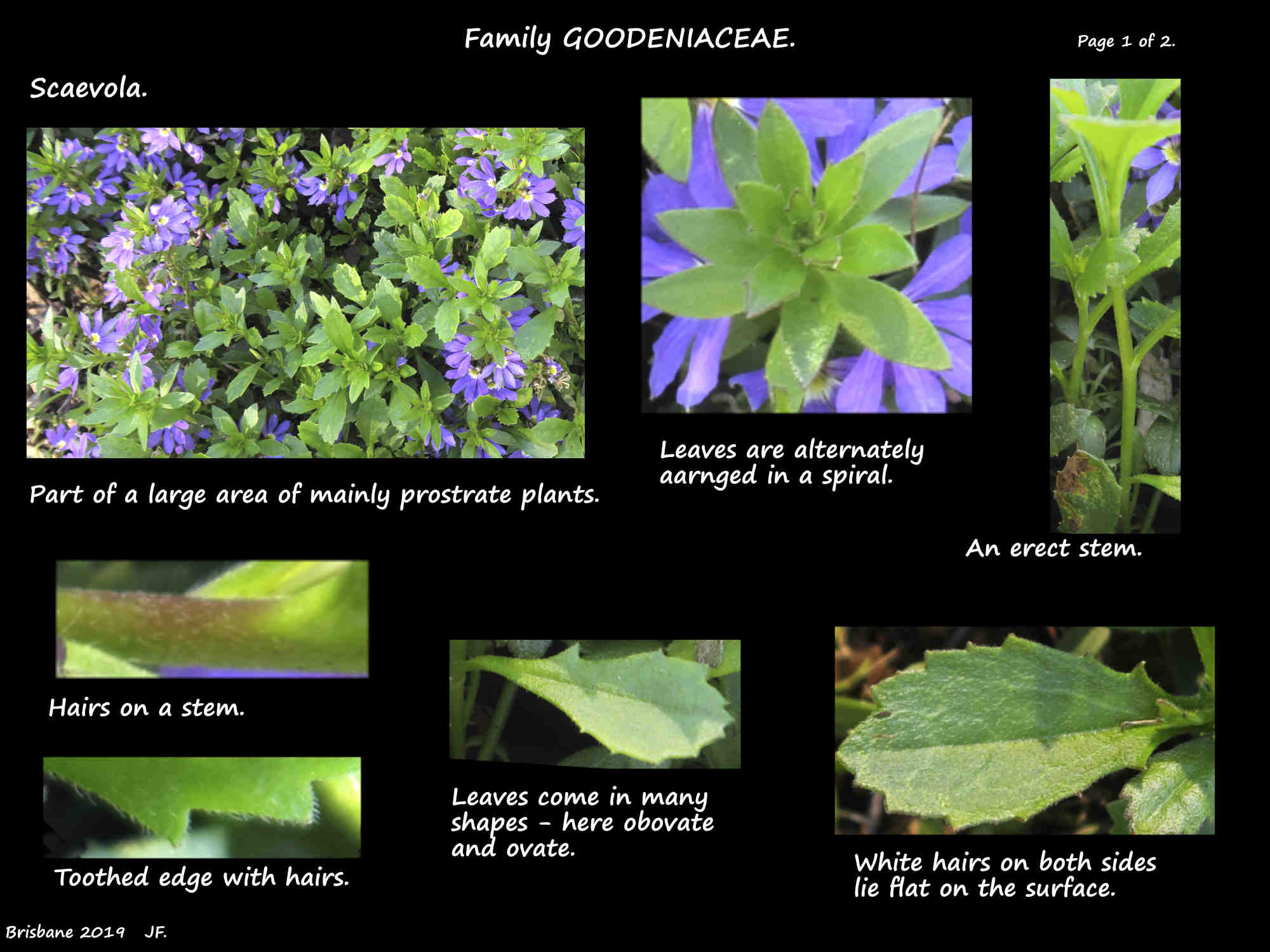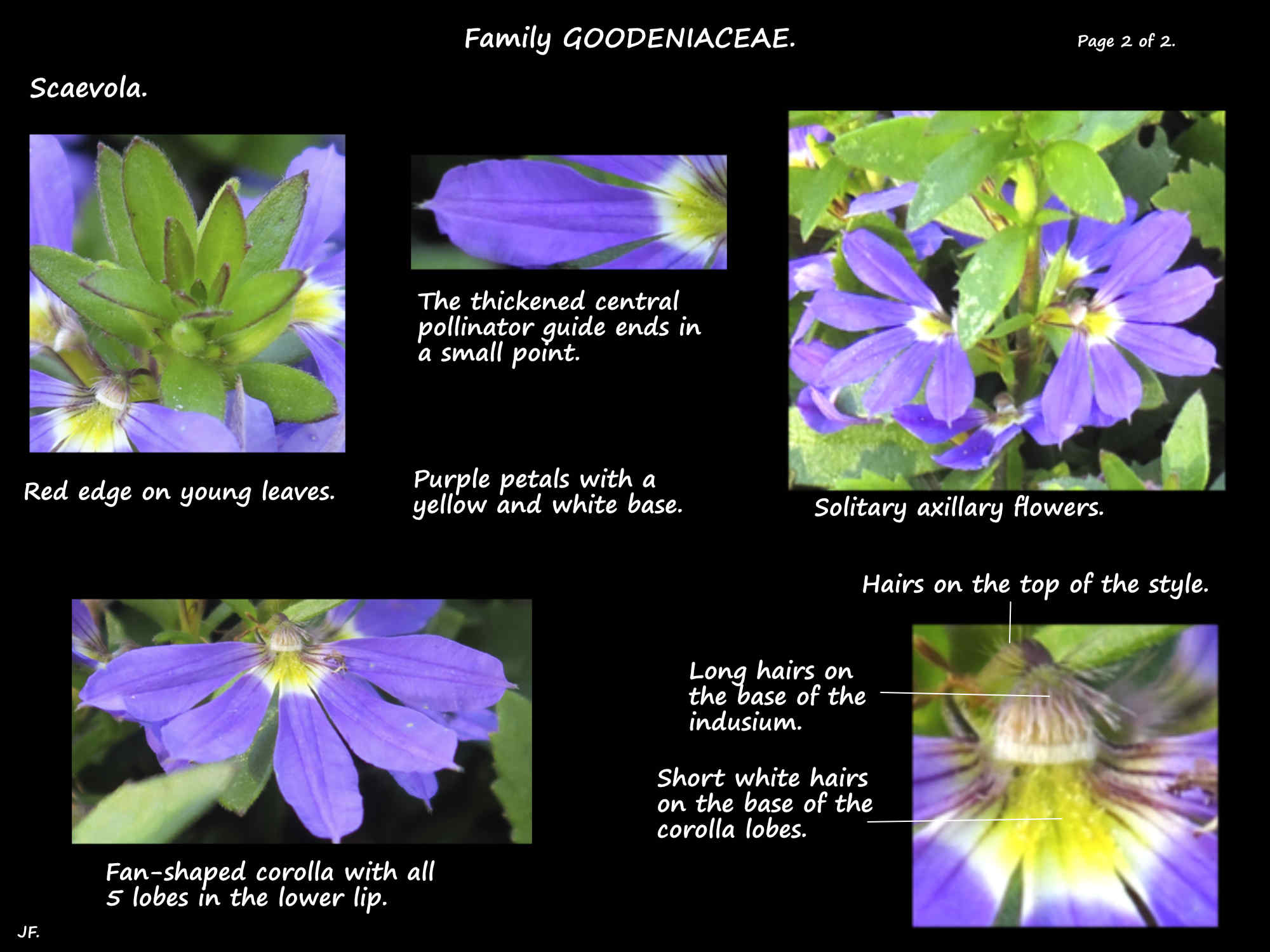Scaevola.
In Family Goodeniaceae, there are around 100 (80 to 130) species of Fan flowers.
They are perennial herbs, scramblers, subshrubs, shrubs or small trees.
Many are prostrate growing from 10 to 50 cm high and 1.5 m wide.
The largest shrubs and trees are up to 3 m high.
Stems can be straight or twisted and with or without ribs.
Some species have thorns on the terminal branches.
Plants may or may not have hairs on various parts.
Hairs can be simple, branched, stellate or glandular and white or yellowish.
They may be fine or coarse, sparse or dense and erect or flattened on the surface.
Where there are glandular hairs the surfaces are sticky.
The sometimes succulent leaves are almost always alternate and rarely opposite.
They may be scattered along the stems or mostly near the base.
They can be sessile or on petioles up to 2 cm long.
The blades are from 1 to 20 cm long and 2 mm to 9 cm wide.
In some species the leaves are reduced to 3 or 4 mm long scales.
Blades can be almost any shape – linear, elliptic, ovate, obovate, oblanceolate, oblong, wedge-shaped or like a spatula.
The blade can be flat or with the edges rolled under and the edge is often dentate.
The surfaces can be smooth to densely hairy with simple or glandular hairs.
There are usually clumps of hair in the axils of the veins.
Axillary inflorescences, up to 20 cm long are a solitary flower or a small cluster.
Flowers may be sessile or on stalks and there are bracts and bracteoles.
The variously shaped bracteoles are around 1 cm long with a smooth edge or teeth.
They may be free of each other or fused along one side.
The stalk above the bracteole is the pedicel.
Sometimes there is no stalk (peduncle) below the bracteole with the bracteole being in the axil of the bract.
Other species have peduncles around 1 cm long.
The bracts may resemble the leaves or be different.
The 5 sepals may be free or fused at the base with lobes to 3 mm long or absent.
Where there is a tube it is fused to the ovary.
There are 5 petals in the corolla with the bases fused into a tube.
The corolla is up to 3.5 cm long and 3 cm across.
The corolla tube splits along its whole length and opens out giving a single lower lip with 5 lobes like a fan.
The lobes are usually all fairly similar in size.
There are wings 1 to 10 mm wide on the petals but there are no auricles.
The outer surface of the corolla can be smooth or slightly to densely hairy.
The long or short, white, yellow or brown hairs may be erect or lie flat on the surface.
The simple or branched hairs inside the throat can be sparse or dense and they may have barbs.
Including the many cultivars flowers are varying shades of blue, purple, mauve, lavender, pink, sometimes
white and rarely yellow. The throat may be yellow or white.
The 5 stamens are free of each other and the anthers sometimes have hairs on the tip.
The inferior ovary has 2 locules (1 to 4) with one ovule in each.
The single style may have some hairs and the stigma is simple or bilobed.
The edge of the cup-shaped indusium usually has bristles.
Its base may be smooth or have sparse to dense hairs that are longer or shorter than the bristles.
These basal hairs can be white or purplish.
The green or black indehiscent fruit can be dry or fleshy and the surface grooved or smooth.
There may be a beak and the simple white or yellow hairs are flattened on the surface.
There is 1 ovoid seed in each chamber.
J.F.



